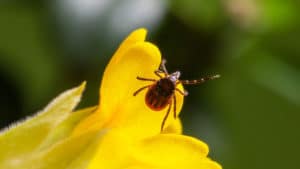The spiral-shaped bacteria (called spirochetes) that cause Lyme borreliosis belong to the genospecies Borrelia burgdorferi sensu lato. While at least four B burgdorferi genospecies have been identified in Europe as causing Lyme disease in humans, only one of these B burgdorferi sensu stricto - has been seen here in the United States until now.
After studying over 100,000 human blood samples and 600 ticks from the upper midwestern part of the United States, Dr. Bobbi Pritt and her colleagues identified a new type of spirochete, using the DNA-based PCR (Polymerase Chain Reaction) testing. This spirochete type was distinctly different than those that can be classified into the previously identified B burgdorferi sensu lato genospecies and was found in a small proportion of samples that also tested positive for other B Burgdorferi sensu lato genospecies. This new genospecies was appropriately named (candidatus) Borellia mayonii, after the Mayo Clinic where it was discovered. It was found in both nymph and adult stages of infected ticks. Whole genome sequencing was one of the molecular analysis techniques used, proving to be a promising new development in diagnostics.
Ticks can carry multiple types of pathogens that cause health problems in both humans and animals, but Lyme borreliosis is the most prevalent tick-borne illness in the northern hemisphere. It can affect various systems and organs of the body, including the skin, nervous system, musculo-skeletal system, and the heart. The physical, emotional, and economic burden of this disease is far-reaching, making continuing research extremely important. The significance of this new finding goes beyond the scientific classification of Lyme-related bacteria. The researchers also examined the medical records of infected patients and found that those infected with B mayonii presented differently than those infected only with B burgdorferi sensu lato. The symptoms that appeared to be specific to B mayonii infection were widespread macular rash (red patches on the skin), vomiting, fever, and a high concentration of spirochetes, with a few patients also experiencing symptoms related to the central nervous system. No deaths were reported. These clinical findings are important for the future of proper diagnosis, treatment, and additional research. Limitations in testing, partly due to the slow growth of spirochetes in the B burgdorferi sensu lato genospecies, make clinical symptoms an important step in diagnosis.
A few of the factors that make Lyme borreliosis so complicated to study and treat in addition to the limitations in testing, are climate change, other environmental factors, and the variation in the different species' abilities to transmit the disease. At this time, it appears that B mayonii is isolated in the upper midwestern part of the United States, but further research is needed regarding geographical distribution. Determining the length of tick attachment time in relation to disease transmission is also needed to help with risk assessment within the affected regions. Interestingly, B mayonii appears to be a newly emerged genospecies, as it was only identified in the samples collected between 2012 and 2014.

